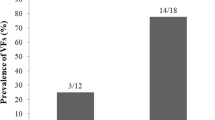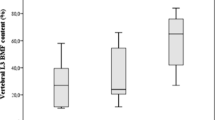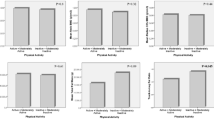Abstract
Background
Klinefelter syndrome (KS) frequently causes skeletal fragility characterized by profound alterations in bone microstructure with increased risk of fractures. Increased body fat mass associated with decreased body lean mass are frequent features of KS with possible detrimental effects on skeletal health. In this cross-sectional study, we evaluated the associations between body composition parameters, vertebral fractures (VFs) and trabecular bone score (TBS) in adult subjects with KS.
Methods
Seventy-one adult males (median age 41 years, range 18–64) with 47, XXY KS were consecutively enrolled by two Endocrinology and Andrology Units (IRCCS Humanitas Research Hospital in Milan and ASST Spedali Civili in Brescia). Dual-energy X-ray absorptiometry (DXA) was performed to assess bone mineral density (BMD) at lumbar spine, femoral neck and total hip, TBS and body composition. Prevalence of VFs was assessed by quantitative morphometry on lateral spine X-rays.
Results
VFs were detected in 14 patients (19.7%), without significant association with low BMD (p = 0.912). In univariate logistic regression analysis, VFs were significantly associated with truncal/leg fat ratio (OR 2.32 per tertile; 95% CI 1.05–5.15; p = 0.038), whereas impaired TBS (detected in 23.4% of subjects) was associated with older age at study entry (p = 0.001) and at diagnosis of disease (p = 0.015), body mass index (BMI; p = 0.001), waist circumference (p = 0.007), fat mass index (FMI; p < 0.001), FMI/lean mass index (LMI) ratio (p = 0.001). Prevalence of VFs was not significantly different between subjects with impaired TBS as compared to those with normal TBS (26.7 vs. 18.4%; p = 0.485). Skeletal end-points were not significantly associated with duration of testosterone replacement therapy and serum testosterone and 25hydroxyvitamin D values.
Conclusion
Body composition might influence bone quality and risk of VFs in subjects with KS.

Similar content being viewed by others
References
Zitzmann M, Aksglaede L, Corona G, Isidori AM, Juul A, T’Sjoen G et al (2021) European academy of andrology guidelines on Klinefelter Syndrome Endorsing Organization: European Society of Endocrinology. Andrology 9(1):145–167
Kanakis GA, Nieschlag E (2018) Klinefelter syndrome: more than hypogonadism. Metab Clin Exp 86:135–144
Bonomi M, Rochira V, Pasquali D, Balercia G, Jannini EA, Ferlin A (2017) Klinefelter syndrome (KS): genetics, clinical phenotype and hypogonadism. J Endocrinol Invest 40(2):123–134
Swerdlow AJ, Higgins CD, Schoemaker MJ, Wright AF, Jacobs PA (2005) Mortality in patients with Klinefelter syndrome in Britain: a cohort study. J Clin Endocrinol Metab 90(12):6516–6522
Bojesen A, Juul S, Birkebaek N, Gravholt CH (2004) Increased mortality in Klinefelter syndrome. J Clin Endocrinol Metab 89(8):3830–3834
Vena W, Pizzocaro A, Indirli R, Amer M, Maffezzoni F, Delbarba A et al (2020) Prevalence and determinants of radiological vertebral fractures in patients with Klinefelter syndrome. Andrology 8(6):1699–1704
Porcelli T, Maffezzoni F, Pezzaioli LC, Delbarba A, Cappelli C, Ferlin A (2020) Management of endocrine disease: male osteoporosis: diagnosis and management - should the treatment and the target be the same as for female osteoporosis? Eur J Endocrinol 183(3):R75-r93
Mazziotti G, Frara S, Giustina A (2018) Pituitary diseases and bone. Endocr Rev 39(4):440–488
Shanbhogue VV, Hansen S, Jørgensen NR, Brixen K, Gravholt CH (2014) Bone geometry, volumetric density, microarchitecture, and estimated bone strength assessed by HR-pQCT in Klinefelter syndrome. J Bone Miner Res 29(11):2474–2482
Piot A, Plotton I, Boutroy S, Bacchetta J, Ailloud S, Lejeune H et al (2022) Klinefelter bone microarchitecture evolution with testosterone replacement therapy. Calcif Tissue Int 111(1):35–46
Tahani N, Nieddu L, Prossomariti G, Spaziani M, Granato S, Carlomagno F et al (2018) Long-term effect of testosterone replacement therapy on bone in hypogonadal men with Klinefelter Syndrome. Endocrine 61(2):327–335
Pedersini R, Amoroso V, Maffezzoni F, Gallo F, Turla A, Monteverdi S et al (2019) Association of fat body mass with vertebral fractures in postmenopausal women with early breast cancer undergoing adjuvant aromatase inhibitor therapy. JAMA Netw Open 2(9):e1911080
de Araújo IM, Parreiras ESLT, Carvalho AL, Elias J Jr, Salmon CEG, de Paula FJA (2020) Insulin resistance negatively affects bone quality not quantity: the relationship between bone and adipose tissue. Osteoporos Int 31(6):1125–1133
Ma WY, Yang CY, Shih SR, Hsieh HJ, Hung CS, Chiu FC et al (2013) Measurement of waist circumference: midabdominal or iliac crest? Diabetes Care 36(6):1660–1666
Genant HK, Jergas M, Palermo L, Nevitt M, Valentin RS, Black D et al (1996) Comparison of semiquantitative visual and quantitative morphometric assessment of prevalent and incident vertebral fractures in osteoporosis The Study of Osteoporotic Fractures Research Group. J Bone Mineral Res 11(7):984–996
Crans GG, Genant HK, Krege JH (2005) Prognostic utility of a semiquantitative spinal deformity index. Bone 37(2):175–179
Hangartner TN, Warner S, Braillon P, Jankowski L, Shepherd J (2013) The Official Positions of the International Society for Clinical Densitometry: acquisition of dual-energy X-ray absorptiometry body composition and considerations regarding analysis and repeatability of measures. J Clin Densitom 16(4):520–536
Schousboe JT, Shepherd JA, Bilezikian JP, Baim S (2013) Executive summary of the 2013 International Society for Clinical Densitometry Position Development Conference on bone densitometry. J Clin Densitom 16(4):455–466
McCloskey EV, Odén A, Harvey NC, Leslie WD, Hans D, Johansson H et al (2016) A meta-analysis of trabecular bone score in fracture risk prediction and its relationship to FRAX. J Bone Mineral Res 31(5):940–948
Dittadi R, Matteucci M, Meneghetti E, Ndreu R (2018) Reassessment of the Access Testosterone chemiluminescence assay and comparison with LC-MS method. J Clin Lab Anal 32(3):e22286
Holick MF, Binkley NC, Bischoff-Ferrari HA, Gordon CM, Hanley DA, Heaney RP et al (2011) Evaluation, treatment, and prevention of vitamin D deficiency: an Endocrine Society clinical practice guideline. J Clin Endocrinol Metab 96(7):1911–1930
Matthews DR, Hosker JP, Rudenski AS, Naylor BA, Treacher DF, Turner RC (1985) Homeostasis model assessment: insulin resistance and beta-cell function from fasting plasma glucose and insulin concentrations in man. Diabetologia 28(7):412–419
Bojesen A, Birkebæk N, Kristensen K, Heickendorff L, Mosekilde L, Christiansen JS et al (2011) Bone mineral density in Klinefelter syndrome is reduced and primarily determined by muscle strength and resorptive markers, but not directly by testosterone. Osteoporos Int 22(5):1441–1450
Foresta C, Ruzza G, Mioni R, Meneghello A, Baccichetti C (1983) Testosterone and bone loss in Klinefelter syndrome. Horm Metab Res 15(1):56–57
Ferlin A, Selice R, Di Mambro A, Ghezzi M, Di Nisio A, Caretta N et al (2015) Role of vitamin D levels and vitamin D supplementation on bone mineral density in Klinefelter syndrome. Osteoporosis Int 26(8):2193–2202
Ferlin A, Schipilliti M, Vinanzi C, Garolla A, Di Mambro A, Selice R et al (2011) Bone mass in subjects with Klinefelter syndrome: role of testosterone levels and androgen receptor gene CAG polymorphism. J Clin Endocrinol Metab 96(4):E739–E745
Pizzocaro A, Vena W, Condorelli R, Radicioni A, Rastrelli G, Pasquali D et al (2020) Testosterone treatment in male patients with Klinefelter syndrome: a systematic review and meta-analysis. J Endocrinol Invest 43(12):1675–1687
Aksglaede L, Andersson AM, Jørgensen N, Jensen TK, Carlsen E, McLachlan RI et al (2007) Primary testicular failure in Klinefelter’s syndrome: the use of bivariate luteinizing hormone-testosterone reference charts. Clin Endocrinol (Oxf) 66(2):276–281
Juel Mortensen L, Lorenzen M, Jørgensen N, Andersson AM, Nielsen JE, Petersen LI et al (2019) Possible link between FSH and RANKL release from adipocytes in men with impaired gonadal function including Klinefelter syndrome. Bone 123:103–114
Rochira V, Antonio L, Vanderschueren D (2018) EAA clinical guideline on management of bone health in the andrological outpatient clinic. Andrology 6(2):272–285
Corona G, Vena W, Pizzocaro A, Giagulli VA, Francomano D, Rastrelli G et al (2022) Testosterone supplementation and bone parameters: a systematic review and meta-analysis study. J Endocrinol Invest 45(5):911–926
Ferlin A, Schipilliti M, Foresta C (2011) Bone density and risk of osteoporosis in Klinefelter syndrome. Acta paediatrica (Oslo, Norway: 1992) 100(6):878–884
Harvey NC, Glüer CC, Binkley N, McCloskey EV, Brandi ML, Cooper C et al (2015) Trabecular bone score (TBS) as a new complementary approach for osteoporosis evaluation in clinical practice. Bone 78:216–224
Aksglaede L, Molgaard C, Skakkebaek NE, Juul A (2008) Normal bone mineral content but unfavourable muscle/fat ratio in Klinefelter syndrome. Arch Dis Child 93(1):30–34
Bojesen A, Kristensen K, Birkebaek NH, Fedder J, Mosekilde L, Bennett P et al (2006) The metabolic syndrome is frequent in Klinefelter’s syndrome and is associated with abdominal obesity and hypogonadism. Diabetes Care 29(7):1591–1598
Chang S, Skakkebæk A, Trolle C, Bojesen A, Hertz JM, Cohen A et al (2015) Anthropometry in Klinefelter syndrome–multifactorial influences due to CAG length, testosterone treatment and possibly intrauterine hypogonadism. J Clin Endocrinol Metab 100(3):E508–E517
Blüher M (2009) Adipose tissue dysfunction in obesity. Exp Clin Endocrinol Diabetes 117(6):241–250
Mazziotti G, Lania AG, Canalis E (2022) Skeletal disorders associated with the growth hormone–insulin- like growth factor 1 axis. Nat Rev Endocrinol 18(6):353–365
Lv S, Zhang A, Di W, Sheng Y, Cheng P, Qi H et al (2016) Assessment of Fat distribution and Bone quality with Trabecular Bone Score (TBS) in Healthy Chinese Men. Sci Rep 6:24935
Melton LJ 3rd (2003) Adverse outcomes of osteoporotic fractures in the general population. J Bone Mineral Res 18(6):1139–1141
Kendler DL, Bauer DC, Davison KS, Dian L, Hanley DA, Harris ST et al (2016) Vertebral fractures: clinical importance and management. Am J Med 129(2):221.e1–10
Bojesen A, Juul S, Birkebaek NH, Gravholt CH (2006) Morbidity in Klinefelter syndrome: a Danish register study based on hospital discharge diagnoses. J Clin Endocrinol Metab 91(4):1254–1260
Mazziotti G, Porcelli T, Mormando M, De Menis E, Bianchi A, Mejia C et al (2011) Vertebral fractures in males with prolactinoma. Endocrine 39(3):288–293
Mazziotti G, Bianchi A, Bonadonna S, Cimino V, Patelli I, Fusco A et al (2008) Prevalence of vertebral fractures in men with acromegaly. J Clin Endocrinol Metab 93(12):4649–4655
Mazziotti G, Bianchi A, Cimino V, Bonadonna S, Martini P, Fusco A et al (2008) Effect of gonadal status on bone mineral density and radiological spinal deformities in adult patients with growth hormone deficiency. Pituitary 11(1):55–61
Waterloo S, Ahmed LA, Center JR, Eisman JA, Morseth B, Nguyen ND et al (2012) Prevalence of vertebral fractures in women and men in the population-based Tromsø Study. BMC Musculoskelet Disord 13:3
Cioffi CE, Alvarez JA, Welsh JA, Vos MB (2019) Truncal-to-leg fat ratio and cardiometabolic disease risk factors in US adolescents: NHANES 2003–2006. Pediatr Obes 14(7):e12509
Choi SI, Chung D, Lim JS, Lee MY, Shin JY, Chung CH et al (2017) Relationship between regional body fat distribution and diabetes mellitus: 2008 to 2010 Korean National Health and Nutrition Examination Surveys. Diabetes Metab J 41(1):51–59
Mazziotti G, Tupputi U, Ferrante G, Guglielmi G (2020) Abdominal aortic calcification as a marker of relationship between atherosclerosis and skeletal fragility. J Clin Densitom 23(4):539–542
Crepaldi G, Maggi S (2009) Epidemiologic link between osteoporosis and cardiovascular disease. J Endocrinol Invest 32(4 Suppl):2–5
Hans D, Šteňová E, Lamy O (2017) The trabecular bone score (TBS) complements DXA and the FRAX as a fracture risk assessment tool in routine clinical practice. Curr Osteoporos Rep 15(6):521–531
Lindsay R, Pack S, Li Z (2005) Longitudinal progression of fracture prevalence through a population of postmenopausal women with osteoporosis. Osteoporosis Int 16(3):306–312
Mazziotti G, Pedersini R, Vena W, Cosentini D, Carrone F, Pigni S et al (2022) Real-world effectiveness of denosumab and bisphosphonates on risk of vertebral fractures in women with breast cancer undergoing treatment with aromatase inhibitors. Calcif Tissue Int. https://doi.org/10.1007/s00223-022-01011-w
Mazziotti G, Vena W, Pedersini R, Piccini S, Morenghi E, Cosentini D et al (2022) Prediction of vertebral fractures in cancer patients undergoing hormone deprivation therapies: reliability of who fracture risk assessment tool (frax) and bone mineral density in real-life clinical practice. J Bone Oncol 33:100421
Foresta C, Ferlin A, Lenzi A, Montorsi P (2017) The great opportunity of the andrological patient: cardiovascular and metabolic risk assessment and prevention. Andrology 5(3):408–413
Funding
This research did not receive any specific grant from any funding agency in the public, commercial or not-for-profit sector.
Author information
Authors and Affiliations
Corresponding author
Ethics declarations
Conflict of interest
All authors declare they do not have conflict of interest that is relevant to the subject matter or materials included in this work.
Research involving human participants and/or animals
The study was approved by the Ethics Committees.
Informed consent
All subjects gave informed consent to use their clinical data for research purposes.
Additional information
Publisher's Note
Springer Nature remains neutral with regard to jurisdictional claims in published maps and institutional affiliations.
Rights and permissions
Springer Nature or its licensor holds exclusive rights to this article under a publishing agreement with the author(s) or other rightsholder(s); author self-archiving of the accepted manuscript version of this article is solely governed by the terms of such publishing agreement and applicable law.
About this article
Cite this article
Vena, W., Carrone, F., Delbarba, A. et al. Body composition, trabecular bone score and vertebral fractures in subjects with Klinefelter syndrome. J Endocrinol Invest 46, 297–304 (2023). https://doi.org/10.1007/s40618-022-01901-8
Received:
Accepted:
Published:
Issue Date:
DOI: https://doi.org/10.1007/s40618-022-01901-8




